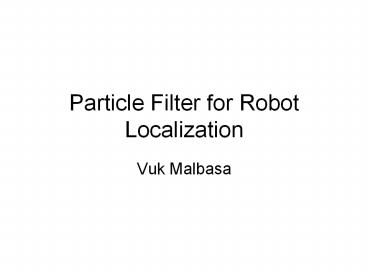Particle Filter for Robot Localization - PowerPoint PPT Presentation
Title:
Particle Filter for Robot Localization
Description:
It is possible to measure distance to dark like from any position ... evaluate. reproduce. end. Particle filters. Evolutionary Computation. Uncanny similarity ... – PowerPoint PPT presentation
Number of Views:46
Avg rating:3.0/5.0
Title: Particle Filter for Robot Localization
1
Particle Filter for Robot Localization
- Vuk Malbasa
2
Problem
- Map is given as bitmap
- It is possible to measure distance to dark like
from any position - Robot needs to find out where on the map it is
located - Only available data is
- Odometry (noisy)
- Range finding (noisy)
- Robot is programmed to follow a particular route
around the map and is allowed to measure at each
time step
3
Robot sensors
- The robot measures distance to wall from several
directions - I assumed that a gyroscope would always let the
robot take measurements from the same angle - Additive noise is simulated in the measurements
as - e N(0,1)
- The robot sees a vector of distances
- To localize the robot needs to find a spot on the
map which has similar distances to what it sees - The measure of similarity
- Given the current robot measurements as the mean
of a normal distribution with a large standard
deviation how likely are the measurements taken
from different locations across the map?
R
4
Measurements
- Sometimes the measurements can be ambiguous
- When there the robot is in a repetitive position
on the map the distance function can be deceiving - This is where odometry helps
- When in the features that the robot sees are
unique to that position on the map then the
distance function has one optimum
5
Measurements
- When the map is complex and the measurements are
noisy then the distance function shows multiple
optima - This leads to the importance of keeping track of
previous positions of particles - While a positions measurements may not be unique
to a particular place on the map, the sequence of
measurements is unique
6
Algorithm
- initialize particles
- for i 1length(movement)
- take measurements from current position
- simulate measurements for particles
- calculate distance function
- assign weights
- resample
- move robot
- move particles
- end
7
Practice
At the beginning of the movement there are many
possible positions because of noisy measurements
and the wide Gaussian distance function After a
few iterations there are only two major positions
left and the biggest one is wrong However once
the robot moves into a place on the map with
unique measurements there is only one position
8
Parallel to evolutionary computation
Particle filters
Evolutionary Computation
- loop
- predict
- evaluate
- resample
- end
loop simulate evaluate reproduce end
Uncanny similarity































